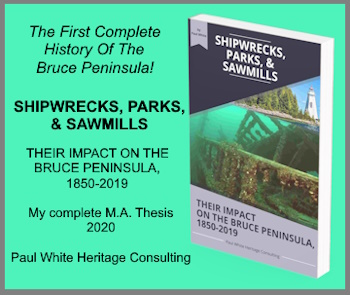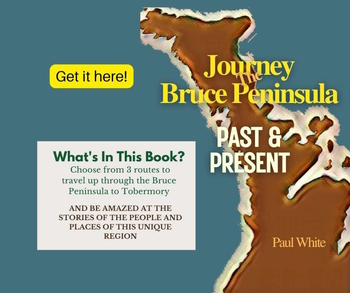Bruce Peninsula Lumbering
Bruce Peninsula lumbering provided the stimulus to develop and grow the pioneer economy on the newly settled Bruce Peninsula.
The shipment of people and produce into and out of a region was an important factor in the economic development of any location. However, the development of the Bruce Peninsula and the Georgian Bay territory, in general, it was the lumbering industry which in fact ignited the expansion in the Georgian Bay region.
Long before settlements began to develop on the Bruce Peninsula, the forest industry was driving the economy of the Canadian colony. Throughout Quebec and the Ottawa River valley, the forests rang with cries of "Timber!" and the rivers, streams, and lakes were highways for timber booms heading to sawmills, and on to Montreal for shipment to markets across the Atlantic.
The ships that carried the squared timber and saw logs needed ballast for their return trip to Canada and, to fill that need, thousands of Irish, Scottish, and English immigrants found a cheap means to bring their families to the new colony to begin a hopefully a better life.
As the timber was cleared from the Ottawa Valley and these new settlers flocked to the area to establish farming communities on the land cleared by lumbering operations. The thirst for more forest products brought the lumber operators across the Mattawa and French river regions into the Georgian Bay area.
With a huge demand for wood products in the now developing American Midwest, trans-Atlantic markets, although still important, efficient transportation to ports such as Chicago and Duluth became necessary.
Consequently, many logs wrre processed at sawmills which sprang up along the Georgian Bay shores. To facilitate these new markets, a maritime transportation industry evolved. Owen Sound and Wiarton newspapers illustrate closer connections between their ports and Chicago, Detroit, Duluth, and other American ports than with Canadian centres.
The first of the peninsula's sawmills was erected at the mouth of the Sauble River in 1862.
For nearly four decades, ending with the First World War, Colpoy's Bay was home to eight sawmills and there were at least 30 other mills located at other points on the Bruce Peninsula.
When the Grand Trunk Railway came to Wiarton in the 1880s, the number of timber booms floated across Georgian Bay increased. At one point, peninsula area sawmills were producing 300,000 cedar railway ties a year to accommodate railway expansion across North America. One Wiarton area pioneer recalled that, at one point, the Grand Trunk was taking 25 carloads of ties and other wood products out of Wiarton on a daily basis.
In 1891, Wiarton lumbermen, Seaman and Newman, won the contract to supply squared hemlock timber to the construction site of the Canadian Canals at Sault Ste. Marie. For the next six years, the company rafted six million feet of squared timber to the "Soo."
In order to efficiently transport such a large quantity o timber, Bruce Peninsula ingenuity was summoned, and the result was a distinctive log boom which changed the manner of boom transport from that point onward.
Sherwood Fox, in his excellent book, The Bruce Beckons, described this distinctive log boom:
“A raft consisted of a crib made of the timbers to be transported; it was 125 feet long and 25-35 feet wide according to the length of the timber in the consignment. The basic framework of the crib was a rectangular boom floating on the water. Into the logs of each long side was bored a row of perpendicular holes, the space between each pair of holes being equal to the thickness of a single timber. Through each hole was thrust upward from the underside of the boom-log a heavy iron rod about 13 feet long. This was really a bolt with its head under water and its thread aloft. On each pair of opposite bolts was laid a timber whose ends had been bored to receive them. In this manner, layer after layer of timbers was piled up to the height of 13 feet. Nuts were then screwed tight on the projecting threads of the bolts. This. bound all the timbers together into a firm, single unit.”
This was not the only innovation created by the ingenuity of the Bruce Peninsula forest products industry. Other inventions such as the lumber hooker also were developed here. In fact, the lumber industry on Georgian Bay spawned a whole new form of maritime ships and shipping methods.
I have often written about the special ties that long time Grey-Bruce families have to maritime travel. This is also true of the Bruce Peninsula lumbering industry. My own grandfather, John White, worked in sawmills for close to 50 years, losing an eye and a thumb in this often-dangerous profession.
A version of this article originally appeared in my Local History column in the Owen Sound Sun Times. For more information about the Bruce Peninsula you can check out my latest book about the region, Journey the Bruce Peninsula Past & Present it makes a great travel companion as you tour this unique part of Canada's Great Lakes region.
Discover More About the Bruce Peninsula
Getting to the Bruce Peninsula is a relatively easy driving trip. Here are driving directions from three regions to the peninsula.
Bruce Peninsula Lumber History details the impact of the forest products industry on the development of the region.
Bruce Peninsula Lumbering provided the stimulus to develop and grow the pioneer economy on the newly settled Bruce Peninsula.
Bruce Peninsula Municipal Politics: No matter what the venue, or the issue, seldom is a popular decision made that suits everyone.
Bruce Peninsula Travel Routes were often a matter of debate because in the early years, land travel was virtually unattainable for settlers and lumbermen alike.
Bruce Peninsula winters could be difficult, especially in pioneer times when transportation connections were limited to only a few months each year.
Colpoys Bay Vista - Awesome! A short drive from either Wiarton or Owen Sound is one of the most magnificent views to be found in the province of Ontario!
Forest Products on the Bruce Peninsula contributed greatly to the growth and development of that region of the province of Ontario.
Gillies Lake: aka Ghost Lake has a mysterious past as its original name, Ghost Lake, implies.
Great Grey Owls on the Bruce Peninsula was a surprise discovery for ornithologists and others. Sadly, the story of their visit had an unfortunate conclusion.
Pioneer Campers: Hope Bay mostly considered the peninsula untamed wilderness and some of the locals were not about to disappoint them!
Pioneer Missionary James Atkey arrived on Colpoys Bay to minister to the native community near Oxenden until a treaty uprooted his parishioners.
Pioneer tourists first visited the Bruce Peninsula in the 1800s and the region continues as a great recreational and tourism destination today!
Pioneer Vacations on the Bruce Peninsula got an eerie start in the Hope Bay region of the peninsula.
Lighthouses Lighthouses were vital to Georgian Bay Sailing.
A Flowerpot Island cruise is not only entertaining, but it is also very educational as you will see things that you have never viewed before!
Travel the Bruce: Owen Sound to Wiarton A wonderful journey from Owen Sound to Wiarton.
Travel the Bruce: Wiarton to Tobermory Relaxing and historic journey.
Bruce Peninsula The Bruce Peninsula is a compelling place, with a rich history, to visit. Once you have traveled there, we guarantee that you will return, again and again!





